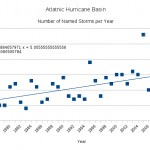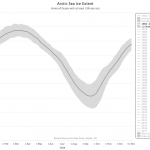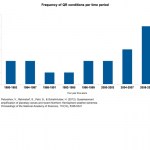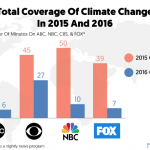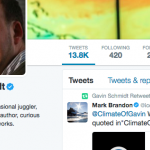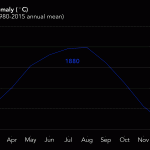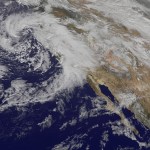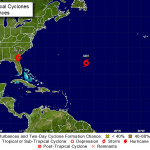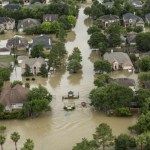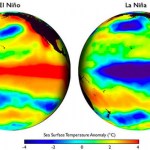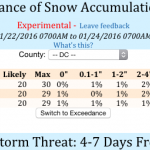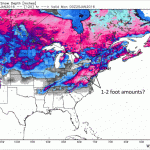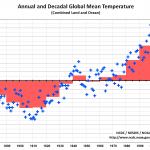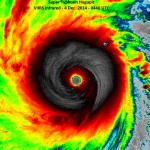Climate and Weather
It isn't. Well, it is a little, but not totally. OK, it is, but actually, it is complicated.
First, you are probably asking about the Atlantic hurricane season, not the global issue of hurricanes and typhoons and such. If you are asking world-wide, recent prior years were worse if counted by how many humans killed and how much damage done.
With respect to the Atlantic, this was a bad year and there are special features of this year that were bad in a way that is best accounted for by global warming. But looking at the Atlantic hurricanes from a somewhat different but valid perspective,…
The climate change documentary A Sea Change will be shown at the Maple Grove Library, in the Western Twin Cities, by the Northwest Minneapolis Climate Action group, this Wednesday at 7:00 PM. See you there!
Here is a trailer:
I had the immense pleasure and great honor of joining Molly, Nick, and Tim on the Geeks Without God podcast to talk about the recent mailing of a book and some other material about climate change to science teachers, by the Heartland Institute. This mailing was an effort to sow seeds of doubt about climate science, but the way they pulled off this little caper will probably have the opposite effect.
The Heartland Institute does not survive this conversation. No kittens or puppies were harmed, though.
Go Here To Listen To the Podcast, and Support Geeks Without God (not safe for work,…
As we pass through Spring on the way to summer, the sea ice in the Arctic is starting to melt. The ice usually peaks by the end of the first week in March or so, then slowly declines for a few weeks, then by about mid-May is heading rapidly towards its likely September minimum.
With global warming the ice has been reaching a lower winter maximum, and a much lower summer maximum. This is caused by warm air and water, and it contributes to global warming. The more ice on the sea for longer, during the northern Summer, reflects away a certain amount of sunlight. With less ice, less sunlight is…
I want to tell you about what may be the most important research result in the area of climate change in recent years. First, a little background.
We know from paleoclimate studies that the Earth's climate system changes from time to time enough to leave a mark. For example, it is widely thought that during the "ice ages" (periods of extensive or moderate glaciation) over the last couple of million years, areas that are currently very dry had a lot more water. Some combination of rain and evaporation (more rain and less evaporation) conspired to fill playas (dried up lakes) or salt lakes (…
Media Matters has an amazing and rather depressing report out on the way broadcast media in the US covered climate change.
I'm going to give you a handful of bullet points that reflect only some of the results of this detailed study, then you go read it.
Bottom line: Coverage in 2016 was a fraction of the previous year, even though there was more climate change news in 2016 than most years ever have.
ABC covered climate change for a total of six minutes during the entire year of 2016
None of the major networks discussed the climate related consequences of a Clinton vs. a Trump presidency…
Scott Adams is the creator of Dilbert, the once funny but now highly repetitive cartoon about a nerd who has a job in an office.
Dr. Gavin Schmidt is high up in the top ten list of world class climate scientists. He is Director of the currently under siege GISS Unit of NASA, where much of the climate science done by that agency is carried out. If you read my blog, you've read his work, because you also read RealClimate, where GS writes about climate science in a manner designed to be understandable to the intelligent, honestly interested, thoughtful individual.
Adams has a history of going…
It is like that stabby lady in the bath tub in that movie.
Here, I'll give you a more readable version of the graphic from NOAA:
The chance of an the Pacific ENSO system being neutral, meaning, not adding extra heat to the atmosphere and not removing extra heat form the atmosphere, is about 50% from now through mid 2017.
But, the chance of a la Nina is pretty darn low, and the chance of an El Nino, which would add more heat to the atmosphere than the average year, is not only approaching 40% but it has been growing.
A second El Nino this close on the last one, which was a very severe El…
Great disasters are great stories, great moments in time, great tests of technology, humanity, society, government, and luck. Fifty years ago it was probably true to say that our understanding of great disasters was thin, not well developed because of the relative infrequency of the events, and not very useful, not knowledge that we could use to reduce the risks from such events.
This is no longer true. The last several decades has seen climate science add more climatic data because of decades of careful instrumental data collection happening, but also, earlier decades have been added to…
The year 2016 was messy and expensive and full of climate change enhanced weather disasters. There were, according to Jeff Masters and Bob Henson, over 30 billion dollar disasters last year.
This is the fourth-largest number on record going back to 1990, said insurance broker Aon Benfield in their Annual Global Climate and Catastrophe Report issued January 17 (updated January 23 to include a 31st billion-dollar disaster, the Gatlinburg, Tennessee fire.) The average from 1990 - 2016 was 22 billion-dollar weather disasters; the highest number since 1990 was 41, in 2013.
The frequency of…
My friend Peter Gleick tosses this question aside and informs us that there are actually better questions. Is California having a wet year? How does the snowpack look? Are the reservoirs filling up? Will the groundwater recharge? Will the forests in the Sierra recover with all this precip? Will farmers get all the water they want this year? Will a wet year help the endangered salmon? Will governor Brown cancel the drought declaration? Can Californians stop conserving water and throw some on their lawn?
It turns out that the answer to most of these questions is not what you would assume…
Update (Mid day Wed):
The disturbance in the eastern Atlantic is now a depression, and it is reasonably likely that it will be a named storm by mid day tomorrow, Thursday.
The predictions for the next several days do not have this storm turning into a hurricane any time soon; it should remain a storm or a depression, possibly going back and forth between the two, for four or five days, but after that, perhaps it will turn into something. Or not. Keep an eye on Karl, if this becomes Karl.
Meanwhile Julia is annoying people in the Southeast, but not doing much. However, keep an eye out for…
The human release of greenhouse gasses has ultimately caused changes in weather patterns so that major storm systems in the Northern Hemisphere get wetter and move along more slowly, causing significant rainfall events to occur at a much higher rate than previously. This has become a nearly ongoing phenomenon, with major floods in Canada, Colorado, Texas, Western Europe, Texas again, various places in Azia, more in Europe, Texas again, and so on.
The short version of the story: The jet stream is often fairly linear, traveling around the planet at a high speed, but it can also get all wavy…
The US NOAA has this video summarizing what they expect for weather in the US as the result of the current, winding down, El Nino:
(function(d, s, id) { var js, fjs = d.getElementsByTagName(s)[0]; if (d.getElementById(id)) return; js = d.createElement(s); js.id = id; js.src = "//connect.facebook.net/en_US/sdk.js#xfbml=1&version=v2.3"; fjs.parentNode.insertBefore(js, fjs);}(document, 'script', 'facebook-jssdk'));
2016 Spring Climate and Flood Outlook
As a near-record El Niño begins to wind down, NOAA issued its spring seasonal outlooks for flooding, drought, precipitation, and…
Friday AM Update: Overall the storm has shifted north. Washington DC is still on track to have something close to two feet of snow in the city, more to the west. The predicted snowfall for New York City, the city that eats meteorologists, is increasing, and The City may see a foot or more, with closer to two feet to the northwest. DC will have its most intensive snowfall during the night on Friday, while New York City will have most of its snow falling during the day on Saturday.
With this northward shift, Boston is likely to get more snow too, possibly over a foot. Snow will start there…
GO HERE FOR THE LATEST UPDATE
See below for update
Jonas, (and no, I do not condone naming of storms that are not tropical cyclones) is going to do bad things to the US East Coast and hinterland.
Imma let you get back to setting your hair on fire over this storm, but first I want to 'splain something to you.
A big No'reaster like this is a big swirling fast moving low pressure system that is drawing potentially huge quantities of moisture off of a global warming and El Niño over-heated Atlantic ocean, driving that moisture inland where it will mix with cold air and turn into various forms of…
I had considered writing an accounting of all the outlandish weather events of 2015, but that project quickly became a tl:dr list of untoward happenings which is both alarming and a bit boring, since it is so long. So, I decided to generate something less comprehensive, focusing more on the context and meaning of the diverse and impressive set of outcomes of anthropogenic global warming, an historically strong El Niño, and, well, weather which is already a pretty whacky thing.
See: Highlights of Climate Change Research in 2015
It should be noted right away that 2015 is the last year in which…
What happened to the Blizzard of 2015? Well, it happened. Despite breathless complaining about how the forecasters got it all wrong, they didn't. As the storm was predicted, there should have been close to about two feet of snow in the New York City metropolitan area, but as it turns out, there was between 8 and 12 inches. That means that New York City experienced a typical winter month's worth of snow in one day. Also, most snow that falls on The City falls a few inches at a time and melts more or less instantly, as few cities can match New York in its heat island effect. So, 8-12 inches…
NOAA will announce today that 2014 was the warmest year during the instrumental record, which begins in 1880. The announcement, which addresses findings of both NOAA and NASA, will be made today at 11:00 Eastern. Below is the press release from NOAA.
I talked about this and other climate matters in a radio interview at Green Divas:
Michael Mann has made the following statements regarding this news:
2014 Was Earth’s Warmest Year On Record
Three major climate organizations (JMA, NASA, and NOAA) have now released their official estimates for the 2014 Global Mean Surface Temperature. Both JMA…
The outer reaches of Typhoon Hagupit are already affecting the target region in the Philippines. Hundreds of thousands of people have fled the areas most under the gun, but the potential for serious problems covers a very large area. The storm has gone through quite a few changes over the last couple of days, but is probably strengthening somewhat right now. No matter what happens, it is going to hit the Philippines as a very serious storm.
Jeff Masters has an update here.
This is the same area that was hit with Typhoon Haiyan last year. Haiyan was a bigger storm. But, Haiyan was also…
